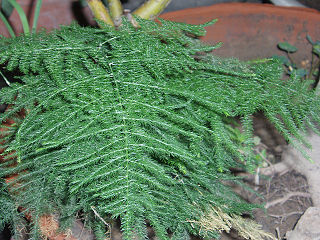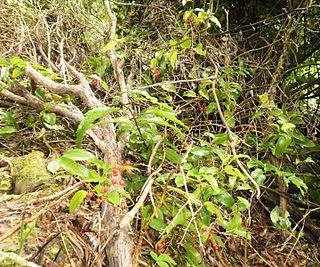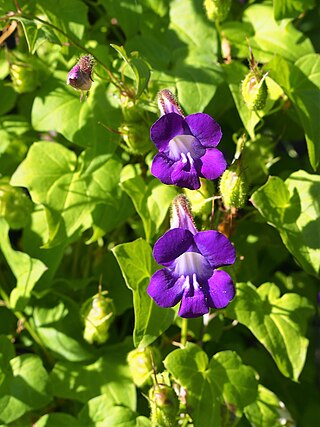
A vine is any plant with a growth habit of trailing or scandent stems, lianas, or runners. The word vine can also refer to such stems or runners themselves, for instance, when used in wicker work.

Austrobaileyales is an order of flowering plants consisting of about 100 species of woody plants growing as trees, shrubs and lianas. The best-known species is Illicium verum, commonly known as star anise. The order belongs to the group of basal angiosperms, the ANA grade, which diverged earlier from the remaining flowering plants. Austrobaileyales is sister to all remaining extant angiosperms outside the ANA grade.

Asparagus is a genus of flowering plants in the family Asparagaceae, subfamily Asparagoideae. It comprises up to 300 species. Most are evergreen long-lived perennial plants growing from the understory as lianas, bushes or climbing plants. The best-known species is the edible Asparagus officinalis, commonly referred to as just asparagus. Some other members of the genus, such as Asparagus densiflorus, are grown as ornamental plants.

Fallopia is a genus of about 12 species of flowering plants in the buckwheat family, often included in a wider treatment of the related genus Polygonum in the past, and previously including Reynoutria. The genus is native to temperate and subtropical regions of the Northern Hemisphere, but species have been introduced elsewhere. The genus includes species forming vines and shrubs.

Austrobaileya is the sole genus consisting of a single species that constitutes the entire flowering plant family Austrobaileyaceae. The species Austrobaileya scandens grows naturally only in the Wet Tropics rainforests of northeastern Queensland, Australia.

Mikania is a genus of about 450 species of plants in the tribe Eupatorieae within the family Asteraceae.

Camoensia is a genus of 2 species of lianas in the family Fabaceae, subfamily Faboideae, native to the Gulf of Guinea, Africa. C. scandens is cultivated as an ornamental plant; it has one of the largest leguminous flowers, up to 20 cm across. The genus has classically been assigned to the tribe Sophoreae, but was recently assigned to its own monophyletic tribe, Camoensieae, on the basis of molecular phylogenetic evidence. Species of Camoensia are known to produce quinolizidine alkaloids, consistent with their placement in the genistoid clade.

Stegnosperma is a genus of flowering plants, consisting of three species of woody plants, native to the Caribbean, Central America, and the Sonoran Desert. These are shrubs or lianas, with anomalous secondary thickening in mature stems, by successive cambia.

Metrosideros fulgens is a forest liana or vine endemic to New Zealand. It occurs in coastal and lowland forest throughout the North Island, on the west coast of the South Island and on the Three Kings Islands north of Cape Reinga. It is one of a number of New Zealand Metrosideros species which live out their lives as vines, unlike the northern rata (M.robusta), which generally begins as a hemi-epiphyte and grows into a huge tree. Scarlet rātā is one of the better-known species of rātā vines, because it flowers in autumn or winter, and is often highly visible on well-lit host trees along forest roads, with vibrant displays of large red flowers that rise above the forest canopy.

Tetracera is a genus of flowering plants of the Dilleniaceae family native to the tropics. Several species are lianas.
Argocoffeopsis is a genus of flowering plants in the family Rubiaceae. It is found in tropical Africa. They are lianas, climbing by means of horizontal or recurved lateral branches, or sometimes shrubs. Their papery bark is grey or brown and peeling off.

Ripogonum scandens is a common rainforest vine endemic to New Zealand. The species was described by Johann Reinhold Forster, and Georg Forster in 1776. It has a conservation status of Not Threatened.
Lasiobema was a genus of flowering plants in the legume family, Fabaceae, most of which are lianas, belonging to the subfamily Cercidoideae. It was recently (2010) synonymized with Phanera on the basis of morphology, although this was questioned and it can be treated as a section of this genus.

Maurandya scandens, also known as trailing snapdragon and snapdragon vine, is a climbing herbaceous perennial native to Mexico, with snapdragon-like flowers and untoothed leaves. It is grown as an ornamental plant in many parts of the world, and has commonly escaped from cultivation to become naturalized. Other names for this plant include creeping snapdragon, vining snapdragon, creeping gloxinia and chickabiddy.
Arthur Johnson Eames was an American botanist who spent over 50 years as faculty member and emeritus professor of botany at Cornell University, known for his work on flower anatomy and plant morphology. He served as president of the Botanical Society of America in 1938, was a member of the American Academy of Arts and Sciences, and received an honorary LL.D. from the University of Glasgow in 1950.

Stixis is a South-East Asian genus of plants in the order Brassicales; they are typically lianas. This genus has previously been placed in the Stixaceae and Capparaceae, but under the APG IV system is now included in the family Resedaceae.
Thinouia is a genus of flowering plants belonging to the family Sapindaceae. It is also in the Sapindoideae subfamily and Paullinieae tribe.
Thepparatia is a monotypic genus of flowering plants belonging to the family Malvaceae. It only contains one known species, the liana Thepparatia scandens.

Limacia is a genus of flowering plants in the family Menispermaceae. It includes three species of lianas native to Indochina and Malesia.
Serjania ichthyctona is a rainforest liana belonging to the soapberry family (Sapindaceae). According to Eames and MacDaniels, this liana's shoots divide into two or more strands like a multistranded rope, making it more flexible and resistant to breakage.













